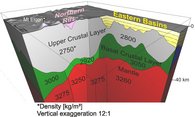Lithospheric strength of the Kenya Rift
The Kenya Rift is part of the East African Rift System and marks a zone along the African continental plate and that is tectonically stretched and thinned, evidenced by earthquake and volcanic activity. We want to understand the controlling factors of present-day and past tectonic deformation. Hence, we assess the structural and strength configuration of the rift system and its surroundings by integrating geological and geophysical observations into 3D numerical models. These data-driven models reveal how the inherited composition of the crust and a thermal anomaly in the mantle interact forming and thus form localised zones of tectonic weakness.
The formation of the continental crust in East Africa dates back to the Neoproterozoic when the East African Orogeny (at ≈650–620 Ma) led to the amalgamation of oceanic crustal fragments and causing continental terranes to form central Gondwana. During the Phanerozoic, the structure and composition of this ancient crustal domain was strongly modified by recurring phases of localised tectonic stretching, crustal thinning, basin formation and magmatism. The most recent of these tectonic phases, spanning the last ca. 45 Ma and involving the emplacement of a thermal anomaly in the mantle, has led to the formation of the Kenya Rift and is responsible for the seismic and volcanic activity affecting the area at the present-day.
Diverse geological and geophysical observations indicate that the crystalline crust of the Kenya Rift and its surroundings is compositionally heterogeneous, structurally complex (with larger thickness variations) and overlain by sedimentary and volcanic rocks of variable composition and thickness. In this project, we integrate multi-disciplinary datasets (including deep refraction seismic profiles) with the observed gravity field to develop consistent 3D models of the lithospheric-scale density configuration in the greater Kenya Rift region. Knowing about the density configuration of the crust provides us with new insights into its compositional variability, which we take in turn as the basis for investigations of the present-day thermal and rheological state of the lithosphere.
Our modelling approach allows us to cross-correlate, for example, (i) lithological domains of the present-day with tectonic events of the past, (ii) measured surface-heat-flow anomalies with observed seismological anomalies in the mantle, (iii) earthquake hypocentres and volcanic centres with the strength configuration of the crust and mantle etc. In this way we aim at a better understanding of the rift evolution, with a particular focus on plume–lithosphere interactions in the past, at present-day and potentially in the future.
Partner
Institute of Earth and Environmental Science, University of Potsdam
Department of Geology, University of Leicester
New Ventures, Upstream International, Shell International Exploration & Production B.V.
Publications
Meeßen, C. (2015): Lithosphere-scale 3-D density model of the Kenya Rift System, PhD Thesis, University of Potsdam, pp. 103.
Sippel, J., Meeßen, C., Cacace, M., Mechie, J., Fishwick, S., Heine, C., Scheck-Wenderoth, M., and Strecker, M. R. (2017): The Kenya rift revisited: insights into lithospheric strength through data-driven 3-D gravity and thermal modelling, Solid Earth, 8, 45-81, doi:10.5194/se-8-45-2017. www.solid-earth.net/8/45/2017/



